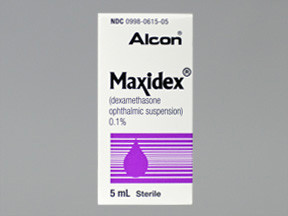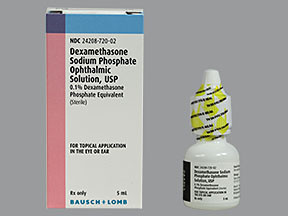DEXAMETHASONE SOLUTION/SUSPENSION - OPHTHALMIC/OTIC
PHONETIC PRONUNCIATION: (dex-a-METH-a-sone)
COMMON BRAND NAME(S): Maxidex
GENERIC NAME(S): dexamethasone sodium phosphate
Uses
USES: This medication is used to treat certain eye conditions due to inflammation or injury. Dexamethasone works by relieving symptoms such as swelling, redness, and itching. It belongs to a class of drugs known as corticosteroids. This medication may also be used to treat swelling, redness, and itching of the outer ear due to inflammatory conditions.
How to use DEXAMETHASONE SOLUTION/SUSPENSION - OPHTHALMIC/OTIC
HOW TO USE: EYE: Unless otherwise directed by your doctor, do not wear contact lenses while you are using this medicine. Sterilize contact lenses according to the manufacturer's directions, and check with your doctor before you begin using them again. If your doctor does approve the wearing of contact lenses during treatment with this medication, remove the lenses before using the eye drops. The preservative in this product may be absorbed by contact lenses. Wait at least 15 minutes after each dose of the eye drop before wearing the lenses again. To apply eye drops, wash your hands first. If you are using a suspension form of this medication, shake the bottle well before using. To avoid contamination, do not touch the dropper tip or let it touch your eye or any other surface. Tilt your head back, look upward, and pull down the lower eyelid to make a pouch. Hold the dropper directly over your eye and place 1 drop into the pouch. Look downward and gently close your eyes for 1 to 2 minutes. Place one finger at the corner of your eye (near the nose) and apply gentle pressure. This will prevent the medication from draining out. Try not to blink and do not rub your eye. Repeat these steps for your other eye if so directed and if your dose is for more than 1 drop. Apply as often as directed by your doctor. Do not rinse the dropper. Replace the dropper cap after each use. If you are using another kind of eye medication (for example, other drops or ointments), wait at least 5 to 10 minutes before applying other medications. Use eye drops before eye ointments to allow the drops to enter the eye. EAR: Clean and dry the ear canal before using this medication. To make sure the right amount of medication is given, and to avoid touching the ear with the dropper, have another person insert the drops if possible. To lower the risk of dizziness, hold the container in your hand for a few minutes in order to warm it. To apply ear drops, wash your hands first. To avoid contamination, do not touch the dropper tip or let it touch your ear or any other surface. If you are using a suspension form of this medication, shake the bottle well before using. Lie on your side or tilt the affected ear upward. Hold the dropper directly over the ear and place the prescribed number of drops into the ear canal. To help the drops roll into the ear of an adult, hold the earlobe up and back. For children, hold the earlobe down and back. Keep the head tilted for 5 minutes, or insert a soft cotton plug if so directed. Alternatively, your doctor may instruct you to place a cotton/gauze plug in the ear canal, moisten it with the medication, and leave it in the ear for 12 to 24 hours or as directed. The plug should be replaced at least once a day. Repeat these steps for the other ear if so directed. Apply as often as directed by your doctor. Do not rinse the dropper. Replace the dropper cap after each use. Use this medication regularly in order to get the most benefit from it. To help you remember, use it at the same time(s) each day. The dosage and length of treatment are based on your medical condition and response to treatment. Do not use this medication more often or for longer than prescribed because doing so may increase your risk of side effects. Continue to use this medication for the full time prescribed. Do not stop using this medication without consulting your doctor. Some conditions may become worse when the drug is suddenly stopped. Your dose may need to be gradually decreased. Do not use this product if it becomes contaminated (for example, drops turn a dark color). Use of contaminated eye medication can cause infection, serious damage to the eye, and loss of vision. Use of contaminated ear medication can cause infection, serious damage to the ear, and hearing loss. Contact your doctor or pharmacist for more information. Tell your doctor if your condition does not improve in a few days or if it worsens.
Side Effects
Precautions
Interactions
Overdose
Images
Reviews
Faq for DEXAMETHASONE SOLUTION/SUSPENSION - OPHTHALMIC/OTIC
Dexamethasone solution/suspension is used to treat various inflammatory conditions in the eyes and ears, such as allergic conjunctivitis, uveitis, and otitis externa.
Dexamethasone is a corticosteroid that works by reducing inflammation and suppressing the immune response in the affected area.
Follow the instructions provided by your healthcare professional. Typically, you will need to shake the bottle well before using the solution/suspension. Tilt your head back and pull down the lower eyelid to create a small pocket. Instill the prescribed number of drops or apply the recommended amount of suspension into the pocket. Close your eyes and gently press your finger against the corner of your eye for about 1 minute to prevent the solution/suspension from draining out of the eye. For otic use, gently clean the affected ear, tilt your head sideways, instill the prescribed amount of solution/suspension into the ear canal, and keep the head tilted for a few minutes to allow the medication to reach the affected area.
Common side effects may include temporary stinging or burning sensation, blurred vision, increased intraocular pressure, and dryness or redness of the eyes. If you experience any severe side effects or allergic reactions, seek medical attention immediately.
Dexamethasone solution/suspension can be used in children, but the dosage and duration of treatment should be determined by a pediatrician or healthcare professional.
Contact lenses should not be worn during treatment with dexamethasone solution/suspension. Remove your contact lenses before using the medication, and wait at least 15 minutes before reinserting them.
The onset of action may vary depending on the condition being treated. It is important to follow the prescribed treatment duration for optimal results. If there is no improvement or worsening of symptoms, consult your healthcare professional.
Before using dexamethasone solution/suspension during pregnancy or breastfeeding, consult your healthcare professional. They will weigh the potential risks and benefits to determine if it is safe for use in your particular situation.
If you miss a dose, apply it as soon as you remember. However, if it is close to the time for your next scheduled dose, skip the missed dose and resume the regular dosing schedule. Do not double the dose to make up for a missed one.
Disclaimer
IMPORTANT: HOW TO USE THIS INFORMATION: This is a summary and does NOT have all possible information about this product. This information does not assure that this product is safe, effective, or appropriate for you. This information is not individual medical advice and does not substitute for the advice of your health care professional. Always ask your health care professional for complete information about this product and your specific health needs.



No Reviews Yet